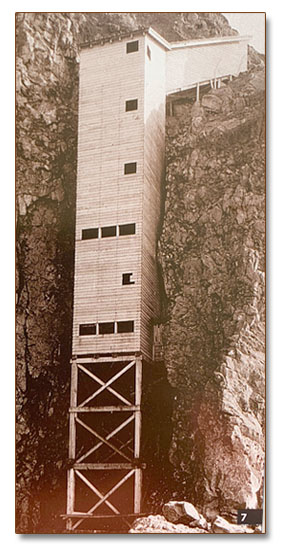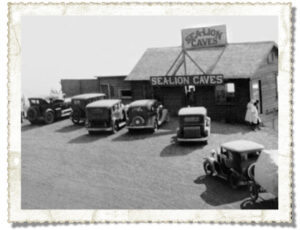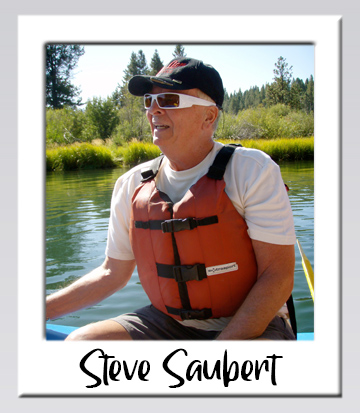STEVE SAUBERT
Part 2, Sea Lion Caves
Oral History Project
“. . . his grandmother, Hannah Saubert managed the business at the Caves – lighting the kerosene lanterns and conducting cave tours. She kept a broom handy to chase back the sea lions each day, all the while utilizing a coffee can for the daily receipts.”
This story is Part 2 of how the Saubert family came to be involved with the Sea Lion Caves (“Caves”).
Records indicate the rocky hillside Caves property was purchased by Captain William Cox in 1887 from the State of Oregon. Steve explained it was not an uncommon method at the time, for the state to sell land to financing schools.
 Following the death of Captain Cox, the Caves property was acquired from the Cox estate by R.E. Clanton in 1927. The State had approved plans in place to build a coastal highway. While providing an accessible roadway, it would allow for a scenic drive by automobile to the Caves. Clanton envisioned opening a tourist attraction featuring the cave and sea lions. He enlisted Johnny E. (“J. E.”) Jacobson and J. Gilbert (“J. G.”) Houghton as business partners. The first challenge the business venture faced was the creation of a safe method for patrons to access the caves. The steep, rocky cliff was a formidable problem to overcome. It involved 3 years of difficult engineering, excavation and construction. In the end, a trail and 135-step wooden stairway was built providing a safe passageway down to the cave entrance.
Following the death of Captain Cox, the Caves property was acquired from the Cox estate by R.E. Clanton in 1927. The State had approved plans in place to build a coastal highway. While providing an accessible roadway, it would allow for a scenic drive by automobile to the Caves. Clanton envisioned opening a tourist attraction featuring the cave and sea lions. He enlisted Johnny E. (“J. E.”) Jacobson and J. Gilbert (“J. G.”) Houghton as business partners. The first challenge the business venture faced was the creation of a safe method for patrons to access the caves. The steep, rocky cliff was a formidable problem to overcome. It involved 3 years of difficult engineering, excavation and construction. In the end, a trail and 135-step wooden stairway was built providing a safe passageway down to the cave entrance.
At one point during the highway construction, contractors inadvertently dumped rock onto the trail resulting in major damage. The partners filed suit against Lane County and won, although the settlement amount was far less than what they requested. Despite the challenges, With great fanfare, the Sea Lion Caves officially opened to the public in August 1932. An admission ticket was 25 cents.
Though initially his idea, the partnership with R.E. Clanton began to wane, and finally, was severed by auction. It was then that Steve’s grandfather, Roy Acme Saubert became a partner. Roy and his wife Hannah had left their successful ice and fish packing plant in Cushman a few years earlier. They relocated to the hills above the Caves. With the coastal highway not yet completed, some may have thought a partnership in the new venture a ‘risky’ one, particularly since travel to the Caves was a cumbersome one. The route was difficult to endure – miles of bumpy, gravel, pot-holed roads. It is no wonder the attendance in the early years was somewhat lean.
 It wasn’t until 1936, after years of construction that the Oregon Coast highway was completed. The new highway brought automobile traffic directly to the Caves. News of the unique attraction gradually spread, and the Caves became a popular tourist destination.
It wasn’t until 1936, after years of construction that the Oregon Coast highway was completed. The new highway brought automobile traffic directly to the Caves. News of the unique attraction gradually spread, and the Caves became a popular tourist destination.
As business grew, so too was a concern for the stability of the concrete foundation supporting the staircase. In 1939, following a bad storm, Houghton and Roy went into the caves. They climbed over the rocks to do an inspection of the foundation. While doing so, it is said a large wave washed both men into the water. Houghton managed to climb back onto the rocks and survived. Tragically, Roy Saubert’s body was never recovered.
When Jacobson and Houghton were away for military service during World War II, Steve’s grandmother, Hannah Saubert managed the Cave. business at the Caves. She lit the kerosene lanterns, conducted cave tours, and was handy to chase back the sea lions each day. A coffee can was used to all the while utilizing a for the daily receipts. In recent years, a fence was erected – not to keep the sea lions back, but to prevent patrons from venturing too close to the sea lions.
Ownership of the Sea Lion Caves passed to the partners’ sons following WWII.
Steve’s dad Clifton returned to the Florence area in 1946 and purchased his mother’s (Hannah’s) share and became a partner. At about the same time, Jack assumed his father, Johnny Jacobson’s partnership. J. G. Houghton’s share was also passed down to his son, resulting in the same 3 families maintaining ownership.
 Steve Saubert has been involved with the Sea Lion Caves most of his life. He recalls growing up and working behind the counter at the age of 14. After high school, he attended Oregon State University, and ultimately graduated from Southern Oregon, with a major in business. Steve then began a successful career in the food service industry with Saga Food Service. His career gave him the opportunity to work in Spokane, Bellingham WA, Moraga CA, and Price, Utah. In 1970, Steve returned to the Sea Lion Caves as General Manager, and remained there for 19 years.
Steve Saubert has been involved with the Sea Lion Caves most of his life. He recalls growing up and working behind the counter at the age of 14. After high school, he attended Oregon State University, and ultimately graduated from Southern Oregon, with a major in business. Steve then began a successful career in the food service industry with Saga Food Service. His career gave him the opportunity to work in Spokane, Bellingham WA, Moraga CA, and Price, Utah. In 1970, Steve returned to the Sea Lion Caves as General Manager, and remained there for 19 years.
In 2006 heirs of the Jacobson and Saubert families purchased the Houghton family’s share to create a fifty-fifty partnership as owners of the Sea Lion Caves. It continues to be a successful destination for all visitors.
View Dr. J.F. Saubert’s story (Steve’s great-grandfather).
